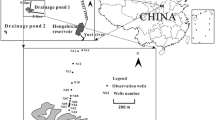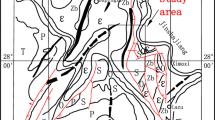Abstract
After a mine is closed, dewatering is discontinued, this may lead to a large increase in groundwater levels and deterioration in water quality, which will threaten the safety of surrounding water supplies. To address this problem, these effects were investigated using the Shanjialin Coal Mine, in Shandong Province, China, as a case study. Following the mine closure, five water quality monitoring points showed that sulfate and total hardness in the mine water were 529 and 685 mg/L, exceeding the allowable groundwater environmental quality standards by 2.1 times and 5.2 times, respectively. This will lead to pollution of the surrounding karst aquifer. A numerical groundwater model was established to simulate the water level rise after the mine closed. The simulation results showed that the mine water level will equal the karst aquifer water level seven years after closure. If the water level in the mine continues to rise above the level of the karst aquifer, it may lead to a deterioration in the karst water quality. Therefore, the mine water level should remain less than 15 m.








Similar content being viewed by others
References
Adams R, Younger PL (2002) A physically based model of rebound in South Crofty tin mine, Cornwall. Geol Soc Lond Spec Publ 198:89–97
Adams R, Younger PL (2010) A strategy for modeling ground water rebound in abandoned deep mine systems. Groundwater 39:249–261
Adamu CI, Nganje TN, Edet A (2015) Heavy metal contamination and health risk assessment associated with abandoned barite mines in Cross River State, southeastern Nigeria. Environ Nanotech Monit Manag 3:10–21
Banks SB, Banks D, Yong RN, Thomas HR (2001) Abandoned mines drainage; impact assessment and mitigation of discharges from coal mines in the UK. Eng Geol 60:31–37
Beane SJ, Comber SDW, Rieuwerts J, Long P (2016) Abandoned metal mines and their impact on receiving waters: a case study from Southwest England. Chemosphere 153:294–306
Bear J (1979) Hydraulics of groundwater. McGraw-Hill Inc., London
Bozau E, Licha T, Ließmann W (2017) Hydrogeochemical characteristics of mine water in the Harz Mountains, Germany. Chemie der Erde–Geochemistry 4:614–624
Gandy CJ, Younger PL (2007) Predicting groundwater rebound in the South Yorkshire Coalfield, UK. Mine Water Environ 26:70–78
Gzyl G, Banks D (2007) Verification of the “first flush” phenomenon in mine water from coal mines in the Upper Silesian Coal basin Poland. J Contam Hydrol 92(1–2):66–86
Hu W, Zhou J, Yan L (2010) Analysis of environmental and safety hazards caused by rebound of abandoned mine water level. J Xi'an Univ Sci Technol 04:436–440
Jeong SW, Wu Y-H, Cho YC, Ji SW (2018) Flow behavior and mobility of contaminated waste rock materials in the abandoned Imgi mine in Korea. Geomorphology 15:79–91
Jin W (2017) Environmental geological hazards caused by abandoned mines and its prevention and control measures. Heilongjiang Sci 20:68–69
Karacan CÖ (2015) Modeling and analysis of gas capture from sealed sections of abandoned coal mines. Int J Coal Geol 138:30–41
Kefeni KK, Msagati TA, Mamba BB (2017) Acid mine drainage: Prevention, treatment options, and resource recovery: a review. J Clean Prod 151(10):475–493
Kotyrba A, Kortas A (2016) Sinkhole hazard assessment in the area of abandoned mining shaft basing on microgravity survey and modelling—case study from the Upper Silesia Coal Basin in Poland. J Appl Geophys 130:62–70
Lee S, Park I (2013) Application of decision tree model for the ground subsidence hazard mapping near abandoned underground coal mines. J Environ Manage 127:166–176
Liu P, Tao Y, Shang M, Yao M (2014) The calculation of mine water yield using the non-continuous flow theory. Environ Earth Sci 71:975–981
Luan M, Wang G, Shi Z, Guo Y, Qing-Yu HX (2016) Simulation of groundwater level recovery in abandoned mines, Fengfeng coalfield, China. J Groundw Sci Eng 4:344–353
Ma D, Rezania M, Yu HS, Bai HB (2017) Variations of hydraulic properties of granular sandstones during water inrush: effect of small particle migration. Eng Geol 217:61–70
Ma D, Cai X, Li Q, Duan H (2018a) In-situ and numerical investigation of groundwater inrush hazard from grouted karst collapse pillar in longwall mining. Water 10:1187
Ma D, Cai X, Zhou Z, Li X (2018b) Experimental investigation on hydraulic properties of granular sandstone and mudstone mixtures. Geofluids 2018:9216578
Ma D, Duan H, Liu J, Li X, Zhou Z (2019) The role of gangue on the mitigation of mining-induced hazards and environmental pollution: an experimental investigation. Sci Total Environ 664:436–448
Oh H, Lee S (2011) Integration of ground subsidence hazard maps of abandoned coal mines in Samcheok, Korea. Int J Coal Geol 86:58–72
Shen B, Poulsen B, Xun L, Qin J, Thiruvenkatachari R, Yi D (2017) Remediation and monitoring of abandoned mines. Int J Min Sci Technol 27:803–811
Shi J, Rubio RM, Durucan S (2016) An improved void-resistance model for abandoned coal mine gas reservoirs. Int J Coal Geol 165:257–264
Smith J, Colls JJ (2010) Groundwater rebound in the Leicestershire Coalfield. Water Environ J 10:280–289
Wang L, Li X, Liu L, Han L (2008) Research on mechanism of groundwater pollution from mine water in abandoned mines. J Coal 14:294–298
Wang F, Duan C, Tu S, Liang N, Bai Q (2017) Hydraulic support crushed mechanism for the shallow seam mining face under the roadway pillars of room mining goaf. Int J Min Sci Technol 27:853–860
Wolkersdorfer Ch (2008) Water management at abandoned flooded underground mines: fundamentals, tracer tests, modelling, water treatment. Springer, Heidelberg
Xue Y, Xie C (2007) Groundwater numerical simulation. Science Press, Beijing
Yan C, Xiang X, Cui Y (2014) Study on environmental geological disasters caused by abandoned mines and their prevention and control. Sci Technol Inf 12:230–231
Younger P (1997) The longevity of mine water pollution: a basis for decision-making. Sci Total Environ 194–195:457–466
Zhou J (2013) Risk analysis on adjacent mine water inrush caused by groundwater rebound of abandoned coal mine. Saf Coal Mines 07:166–168
Acknowledgements
This work was supported in part by the National Natural Science Foundation of China Grants (Young Scientists Fund) 51509064 and 51309071. We thank Paul Seward, PhD, from Liwen Bianji, Edanz Group China and Springer Nature Author Services for editing the English text of this manuscript. Data used to produce this paper are available on contact of the first author. The first author would like to thank the financial support by the Belt and Road Special Foundation of the State Key Laboratory of Hydrology-Water Resources and Hydraulic Engineering (2018nkms06). The authors would like to acknowledge the editor and four anonymous reviewers for their valuable comments for the improvement of this paper.
Author information
Authors and Affiliations
Corresponding author
Additional information
Publisher's Note
Springer Nature remains neutral with regard to jurisdictional claims in published maps and institutional affiliations.
Rights and permissions
About this article
Cite this article
Liu, P., Gao, Y., Shang, M. et al. Predicting water level rises and their effects on surrounding karst water in an abandoned mine in Shandong, China. Environ Earth Sci 79, 51 (2020). https://doi.org/10.1007/s12665-019-8798-7
Received:
Accepted:
Published:
DOI: https://doi.org/10.1007/s12665-019-8798-7




